Studio Install Case Study
TAG Basics
A view from within
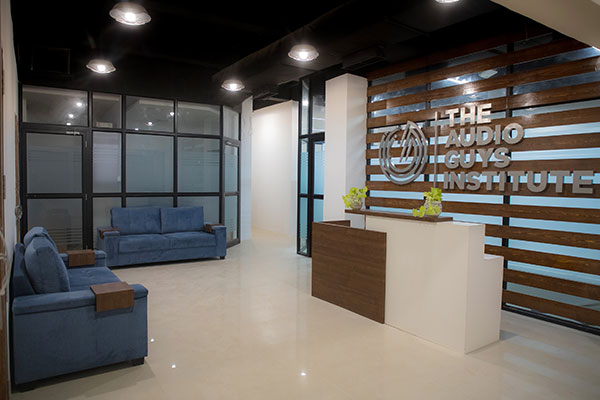
TAG is a modern day audio institute in India’s fast evolving audio education segment. State-of-the-art technology in all three studio suites at the institute is ensuring that TAG is emerging as a front runner in this space. PT reports.
Why does education for sound and music in India and abroad have such different standards and what is the root cause of a sub-par education quality in India?” – a question that kept echoing in the minds of Omkar Tamhan, Anupam Sathe and Jayakrishnan Nalinkumar, the trio behind The Audio Guys Institute (TAG).
What do you do if you have a question that hits home? Either find the answers or blame it on the system? The 3 sound engineers opted for the first and started developing and building a curriculum that aimed at imparting the best tutoring in audio engineering, while also attempting to be economically affordable. Driven by determination and their problem-solving attitude the three collaborated to make their vision a reality and thus was born TAG Studios.
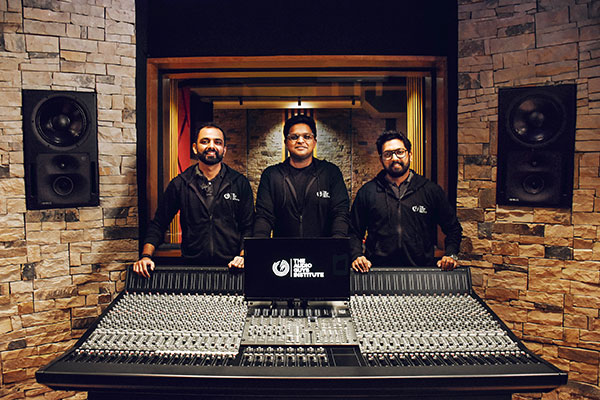
The TAG Trio; L to R: Anupam Sathe, Omkar Tamhan and Jayakrishnan Nalinkumar
Trained in Carnatic Classical Music and keyboards Jayakrishnan, JK, as he is more fondly known in the industry has worked with several legendary artistes like Ustad Zakir Hussain, Fazal Qureshi, Rakesh Chaurasia and Pete Lockett, among many others and has been recording and mixing songs from the past 14 years. He has also won the coveted IRAA (Indian Recording Arts and Academy) Awards for two consecutive years in various categories including the 2018 IRAA for Dronacharya Award for Teachers in Audio Education.
He has lately been associated with leading media colleges in India pursuing his passion for teaching along with Anupam Sathe, an IT engineer, trained Hindustani Classical Vocalist with a masters’ degree in Music. An ace in recording and mixing in the music and film industry, Anupam is also a Live Sound Engineer who has worked with popular bands across Mumbai.
Omkar, a drummer by origin is now a known name in the Sound Post industry and is a technical and business head for multiple studios and production houses in Mumbai. He has been associated with some of the big ticket Bollywood films like Laxmii, Sadak 2, Tanhaji, Kalank, Padmaavat and the upcoming Brahmastra to name a few.
Both JK and Omkar are Audio Production graduates from SAE Byron Bay, Australia.
THE CAMPUS
Located in the heart of Mumbai City, the team wanted to be in the vicinity of the industry to attract professionals to collaborate with their students. “We soon realized that to push the barriers of education, we will need to also integrate world-class facilities and a professional educational environment. That is how we decided and planned the Mumbai campus of TAG,” says Jayakrishnan.
TAG was also looking for a place with adequate height as one of their studios was to host a large format console capable of recording large multitrack sessions like orchestras and a complete band. “We ended up placing ourselves in Shah Industrial Estate, which allowed us walking access to all major studios and production houses while offering us 14ft clearance in our ceiling,” informs Jayakrishnan.
The location and building of TAG awarded the guys with an industrial thick slab. What this meant for the guys is that they could incorporate much heavier construction without worrying too much about the load. Majority of the acoustic isolation from exterior noise has been achieved with thick double walls for all the rooms, isolation ceilings as well as semi floating floors. The internal treatment of TAG studios has been carefully designed as each room has been built for a specific purpose.
STUDIO SITEMAP
The TAG Institute has three studios on campus accessible to students at all times during the given time of the course. The studios are equipped with over 50 microphones, and an assortment of outboard gears from the likes of Manley, Earthworks, Genelec, SPL, Focusrite and more. TAG Studios was designed by the trio with the expert technical guidance from the famous and esteemed duo of the Indian engineering fraternity in India - Mujeeb Dadarkar (former IRAA Director) and Vijay Benegal (IRAA Director for 2021). “Their company OdBle has provided us the right team to execute the design into reality with pristine precision,” informs Jayakrishnan.
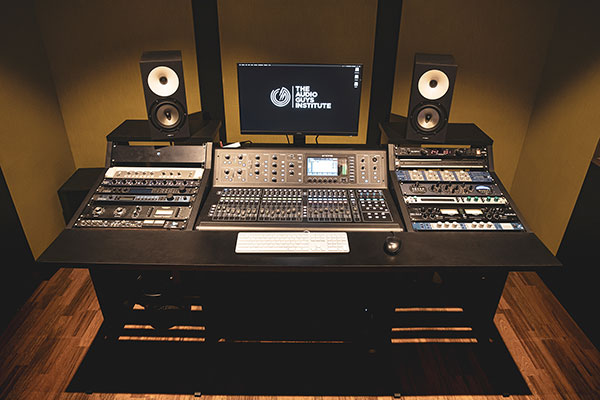
Studio A - Control Room features MIDAS-32 console. The room is designed for recording vocals, guitars and solo instruments
Studio A
The room features a Midas M-32 mixing console, which is known for its digitally operated analog workflow with class electronics for both studio and sound reinforcement. “Students are introduced to the world of recording studios here first. They also have access to exclusive outboard gear and almost a dozen small and large diaphragm condenser microphones as well as various dynamic and specialty microphones,” informs Anupam. With the attached live room, students and professionals can track vocals, instruments or small groups/bands or even change this into a dubbing or foley setup along with high quality video reference. “Our Music Production students also use this space to learn the basics of recording and use of synthesis,” he adds further.
Inventory
Studio A features a MIDAS M-32 console, 2 pairs of near field monitors, Amphion 118s and a pair of Sonodyne SM 100s. Preamps like the Focusrite ISA 428 and Manley Core, SPL transient designer, ART Pro VLA’s for Dynamics and couple of rack units from TC electronics for effects. “This room has the most balanced amount of outboard gear for the room duties which helps us explain students the different usage and quality of outboard gear in audio,” says Omkar.
Acoustic Treatment
Since Studio A is the smallest out of the three studios, it has been designed to produce a tighter sound making it ideal for recording vocals, guitars and other solo instruments as well as small groups. TAG was able to achieve this with a large amount of absorptive surfaces with varying depths. The control room of Studio A is also a tight nearfield monitoring environment ideal for song mixing as well as for music production.
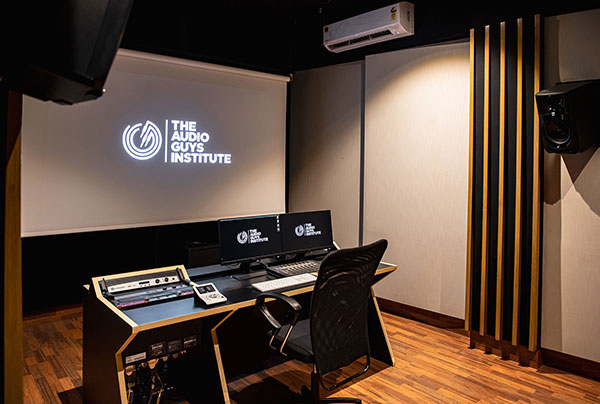
Studio B known as the Audio Post Mix room features the first Dolby 7.1.4 HE room for education purposes.
Studio B
Studio B is also known as the ‘Post Room’. This is where two of the main courses are taught. The room is mainly focused to help students of TAG Institute learn the core workflows of audio post production right from stereo to 7.1.4 ATMOS. “We have a couple of mic pres in the room and a cozy little recording booth attached to this studio. Here students can record ADR, foley and even some music cues if required for their projects,” informs Jayakrishnan. The room is equipped to handle and teach all styles of post-production workflows. The Audio Post Mix Room is also the first Dolby 7.1.4 HE room for education in India.
Inventory
Studio B is a Dolby 7.1.4 HE room. JBL has provided the 7 series speakers for the screen and 3 series speakers for the top and back surrounds. There is a 3635 Subwoofer for the LFE channel and all of it is powered by DSI 1000 amps. The main audio interface of the studio is a Focusrite Red 8PRE. The calibration of the speakers was done by JBL Intonato. The room also has the AVID S1 controller with the Avid Dock, making TAG one of the first Institutes in India to own the S1. The room also features Protools Ultimate with voice packs to help in heavy post-production sessions.
Being an ATMOS facility, Studio B became a challenge for TAG, as speakers were placed on the walls, and on the ceiling. For the room to achieve a great monitoring experience with superior intelligibility and imaging, the right amount of reverberation time and diffusion was crucial. The placements and angling of the speaker was first simulated and then installed as per Dolby recommendations.
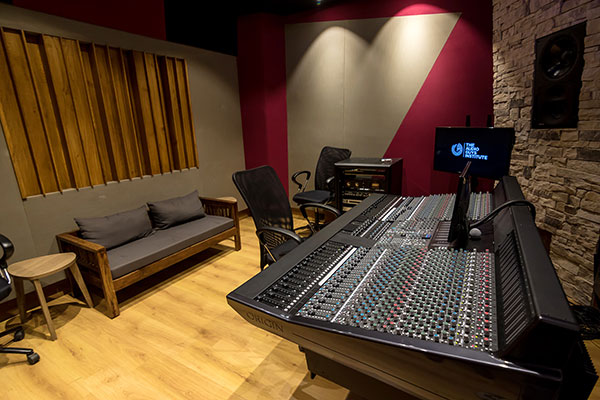
Studio C - Control Room houses the 32-channel SSL Origin - the first of its kind installed in Asia-Pacific for education purposes
Studio C
The Studio houses the mothership of all – SSL Origin. The classic large-format console-style recording studio has been mainly curated for students to learn and manage larger recording sessions like orchestras and large bands. “Having legacy processing on each individual channel also allows us to teach the tips and tricks of the trade using industry classic signal processors like the 4000 E series EQ or the SSL G Bus Compressor. This in turn also educates our students to optimize use of the all those awesome emulations for their in-the-box mixes,” says Omkar.
Origin of a Better User Experience
Commenting on the massive 32 channel SSL Origin analog console, JK says, “The console allows us to have 32 inline channel strips with E Series EQ and the classic SSL center section with integrated bus compressor on the board itself. What makes it more special is that this is the first SSL Origin to be installed for educational purposes in all of Asia-Pacific and also currently the only one in India.”
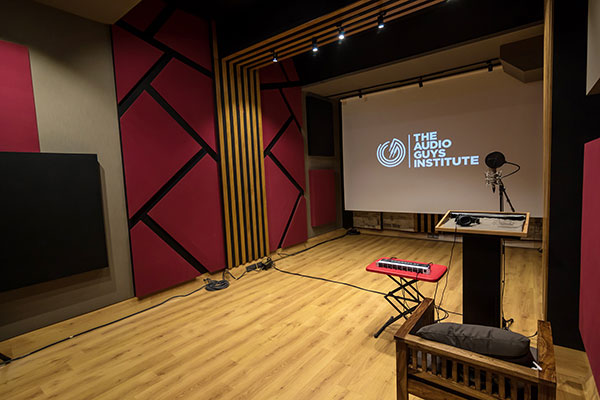
Studio C - Live Room features a live-end dead-end scheme with more absorption
“We were very clear on one thing from the beginning that in order to teach the modules we were planning, a large format console and a large recording room were mandatory requirements,” he adds.
Since the SSL Origin had not been announced at that time by the company, the team was looking at other popular options in the large-format console segment that would meet their requirements as well as budget.
Almost at the brink of deciding on another console, a meeting was set up between the guys from TAG and Anthony Gofton, Vice President – Asia Pacific, SSL. All this happened a few days before the SSL Origin was launched at NAMM.
Even though Anthony was being secretive about the details of the console, he was able to answer all questions raised by the TAG team. “Once we knew that the SSL was ticking all the right boxes we were looking for and was offering us additional features like the 4000 style EQ, integrated LF/SF workflows, it was only a matter of asking when we could expect the console,” adds an elated Jayakrishnan.
The SSL Origin was delivered right before the world swindled down in a pandemic. However, Shiv Sood from Sound Team sorted most of the issues for the team. The overall experience of getting the SSL was smooth and hassle-free for TAG.
SSL has been unique with their product design and the thought process behind the Origin. As companies around the world are rushing to integrate a hybrid workflow which has been a hit or miss integrating DAW’s in consoles, SSL decided to go the 100% analog route while providing seamless integration in a hybrid environment. “The inline architecture also helps us expanding the workflow and adapt to a recording, mixing or summing environment easily. Things like 0dB fader are tiny buttons on the console but it’s the thought that has made every engineer’s life easier working on the SSL Origin,” informs Anupam. “The EQ’s are mind blowing that really helps during recording or even while summing or stem mastering. The central bus routing and also the overall compact design helps to reach out easily to all the controls and thus work faster,” he adds further.
Inventory
The studio also has a pair of Genelec 1237A as the studio’s main monitors and a pair of Amphion 118 as nearfield. In terms of outboard, the interface and converter is the Antelope Orion 32 plus, a selection of microphone preamps like the Cranesong Flamingo, Manley Core and Focusrite ISA 428. Studio C also has an API 2500 Bus Compressor and TC Electronics Effects Processor. Along with these outboard, the studio has a collection of dynamic, condenser and ribbon microphones from Shure, Neumann, Sennheiser, Earthworks, AKG, Rode and Audix.
All the equipment has been primarily provided by Sound Team, Shalu Music, Ansata Electronics, Pro Media and Electronic Emporium to name a few. “The curation of TAG would not have been possible without the amazing distributors and service providers who came all along to help us bring our dream into a reality. They have also contributed immense amounts of efforts and time towards TAG,” says JK.
Along with the equipment that is at par with international standards, the studio also features a large recording room that can accommodate up to a 25-piece Orchestra or a large Live Band.
Acoustic Treatment
The Live Room in Studio C features various acoustic properties in different spots. “We followed a Live-End Dead-End scheme with more absorption towards one side and a reflective one towards the other,” informs Anupam. The reflection aspect of the studio was achieved with natural stones to ensure a rich texture when tracking live instruments. The diffusion panels also help in providing a right balance and scatter especially while tracking louder sources. “The room is ideal for small and large recordings. Our percussion, drums and orchestral recording sessions have given some amazing results,” adds Anupam.
The control room of Studio C has a Mid Field monitoring flush mounted on stone finished wall and also has quadratic diffusors to the rear. The membrane absorbers to the corners and the diffusive clouds to the top help tighten the space. The flush mounted walls and speakers are angled at about 82 degree ensuring optimum balance of acoustic wavefront at the sweet spot. The wider speaker placement also helps in a wider sweet spot that aids judgement even while moving out to the console edges.
Computer Lab
This space hosts 7 Apple iMac computers with MIDI controllers from MAudio Air as well as the Axiom series. The computer lab is utilized for classes as well as student’s extensive DAW training and individual practice to get them work really fast to easily adapt to the industry demands. This room trains students to be proficient in DAW’s such as Avid Protools, Apple Logic, Steinberg Cubase and Ableton. The room also has JBL 308 active monitors as well as the Focusrite Scarlett series soundcard.
Challenges
Like many other businesses, the COVID-19 pandemic proved to be the biggest challenge for TAG, as this delayed the setup and launch of the studio.
TAG Institute started its setup phase in October 2019 and the plan was to have the studios up and running by March 2020. “The Pandemic and the lockdown that followed turned out to be the biggest challenge for us. We were in a 90% completed stage when the nation went to a complete lockdown,” says JK.
TAG had to tweak the curriculum to adapt to an online mode of teaching wherein they had to incorporate a lot of visual learning and this involved a lot of video recording and preparing presentations. Microsoft Teams was used as the online platform for students to attend the virtual classroom. “Our online model of education helped us continue classes without any hindrances,” says a proud Tamhan.
Once the lockdown was lifted and the government started allowing people to move around, the team met at the Institute to assess the situation. Though the lockdown affected their plans and timelines, the team was able to fuse a schedule where construction work would finish parallel with the professional work happening at TAG.
After all the ups and downs, the rollercoaster ride and almost 12 months since commencement TAG officially announced its completion in October 2020. “We have learnt that adaptability is key for any business to sustain through such a phase and we are now happy about our decisions and how we have progressed through such a phase.”
The institute currently offers a 12 month diploma course in each of the segments - sound engineering and music production. It also offers a three-month advanced certificate in postproduction and a six-month advanced certificate in music production.
Conclusion
Currently, the majority of the work is being contributed by the post audio industry. “We have been seeing a shift in the industry lately as more and more musicians are now planning their releases for 2021. Music and post I feel will be equal contributors for professional work at TAG,” informs JK.
Some notable work that TAG has worked on include Ak vs Ak (Netflix), Chalaang, Coolie No.1, Laxmii, BBC Criminal Justice, Radhe, Big Bull, Taish and more.
TAG has received positive feedback from across the board and professionals in the industry complementing them for the design of the space. With spacious studios compared to what is being offered by other studios in Mumbai, when you step into TAG it feels like a breath of fresh air.
“In the past few months our staff and team has been tested as we have managed to accomplish work on 19 titles in the last quarter. Our students are also happy and has been enjoying the model of education in spite of the challenges faced due to the Pandemic,” concludes a proud JK.